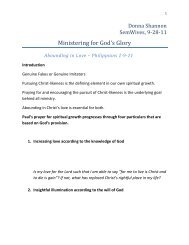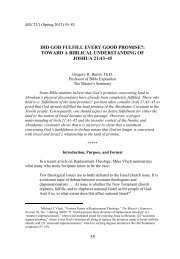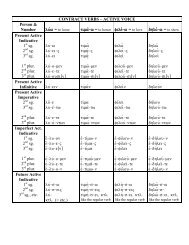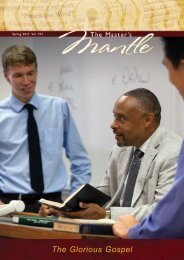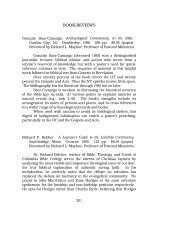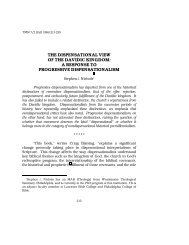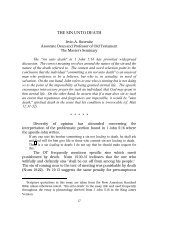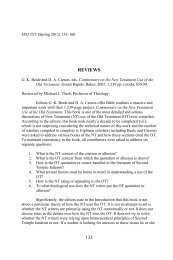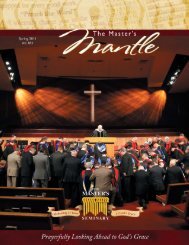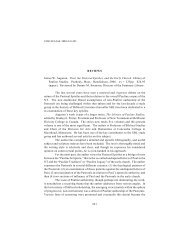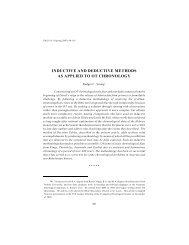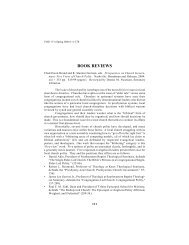dynamic equivalence: a method of translation or a system
dynamic equivalence: a method of translation or a system
dynamic equivalence: a method of translation or a system
- No tags were found...
You also want an ePaper? Increase the reach of your titles
YUMPU automatically turns print PDFs into web optimized ePapers that Google loves.
Dynamic Equivalence . . . 159starting point in hermeneutics, that <strong>of</strong> the <strong>or</strong>iginal text, is no longer acceptable as acontrol in interpretation, if it ever was. Criticisms <strong>of</strong> the grammatico-hist<strong>or</strong>ical<strong>method</strong> <strong>of</strong> interpretation are <strong>of</strong>ten direct and uninhibited. 50 It is clear that thehermeneutical focus has shifted dramatically from the <strong>or</strong>iginal setting <strong>of</strong> Scriptureto a variety <strong>of</strong> contemp<strong>or</strong>ary issues that have become interpretative controls.Trends in TranslationContemp<strong>or</strong>ary trends in <strong>translation</strong> have paralleled those in hermeneutics.The traditional <strong>method</strong> <strong>of</strong> <strong>translation</strong> adopted the source message as its controland sought to bring the contemp<strong>or</strong>ary reader back to that point. 51 Most recentpreferences in <strong>translation</strong> express the opposite goal, that <strong>of</strong> bringing the sourcemessage into the twentieth century to the contemp<strong>or</strong>ary reader. 52 The new aim isto relate the text to the recept<strong>or</strong> and his modes <strong>of</strong> behavi<strong>or</strong> relevant within thecontext <strong>of</strong> his own culture, a controlling fact<strong>or</strong> called "the principle <strong>of</strong> equivalenteffect." 53 The traditional <strong>method</strong> <strong>of</strong> taking the recept<strong>or</strong> to the text seeks to help thereader identify himself with a person in the source-language context as fully aspossible, teaching him the customs, manner <strong>of</strong> thought, and means <strong>of</strong> expression <strong>of</strong>the earlier time. With D-E, comprehension <strong>of</strong> the patterns <strong>of</strong> the source-languageculture is unnecessary. 54 The prime concern given to effective communication by50E. g. Kraft, Christianity in Culture 131, 136-137; W. S. Las<strong>or</strong>, "The Sensus Pleni<strong>or</strong> and BiblicalInterpretation," Scripture, Tradition, and Interpretation (Grand Rapids: Eerdmans, 1978) 266; see alsoScholer, "Issues" 9.51Nida, Toward a Science 165.52Ibid., 166; Glassman, Translation Debate 74; H. M Wolf, "When `Literal' Is Not Accurate," TheNIV`The Making <strong>of</strong> a Contemp<strong>or</strong>ary Translation (Grand Rapids: Zondervan, 1986) 127. Jerome's LatinVulgate has <strong>of</strong>ten been used as an early example <strong>of</strong> <strong>dynamic</strong> <strong>equivalence</strong> <strong>or</strong> idiomatic <strong>translation</strong>because Jerome expressed the purpose <strong>of</strong> translating "sense f<strong>or</strong> sense" rather than "w<strong>or</strong>d f<strong>or</strong> w<strong>or</strong>d"(e.g. see Nida, Toward a Science 13; J. Beekman and J. Callow, Translating the W<strong>or</strong>d <strong>of</strong> God [GrandRapids: Zondervan, 1974] 24). This widely used quotation <strong>of</strong> Jerome is wrongly used, however,because Jerome adds an imp<strong>or</strong>tant qualification to his statement that is not usually noticed: "exceptf<strong>or</strong> Holy Scripture where even the w<strong>or</strong>d <strong>or</strong>der is sacred" (Epistle LVII, in Jerome: Lettres [ed. JeromeLabourt; Paris, 1953] III, 59, cited by Harvey Mink<strong>of</strong>f, "Problems <strong>of</strong> Translations: Concern f<strong>or</strong> theText Versus Concern f<strong>or</strong> the Reader," Biblical Review 4/4 [Aug 1988] 36). Mysterium, the Latin w<strong>or</strong>drendered "sacred" in this quotation, is rendered "a mystery" by others (Philip Schaff and HenryWace, A Select Library <strong>of</strong> Nicene and Post-Nicene Fathers [Grand Rapids: Eerdmans, 1954] 6:133),because mysterium and sacramentum were used almost interchangeably by the Latin Fathers to referto holy things (A. Dulles, "Mystery in Theology," New Catholic Encyclopedia [Washington: TheCatholic University <strong>of</strong> America, 1967] 10:152). Regardless <strong>of</strong> the English rendering <strong>of</strong> this w<strong>or</strong>d,however, the fact remains that because <strong>of</strong> its inspiration, Jerome put Scripture into a special categ<strong>or</strong>ythat required m<strong>or</strong>e literal <strong>translation</strong> principles than other literature. His Vulgate was theref<strong>or</strong>equite literal (Mink<strong>of</strong>f, "Problems" 36).53Ibid., 159. Mink<strong>of</strong>f describes f<strong>or</strong>mal <strong>equivalence</strong> in different terminology. It produces a "text<strong>or</strong>iented"<strong>or</strong> "overt" <strong>translation</strong> because <strong>of</strong> its persuasion that the meaning lies in the text. D-E on theother hand produces a "reader-<strong>or</strong>iented" <strong>or</strong> "covert" <strong>translation</strong>, assuming that meaning inheres inaudience reaction to the text (Mink<strong>of</strong>f, "Problems" 35).54Ibid.



